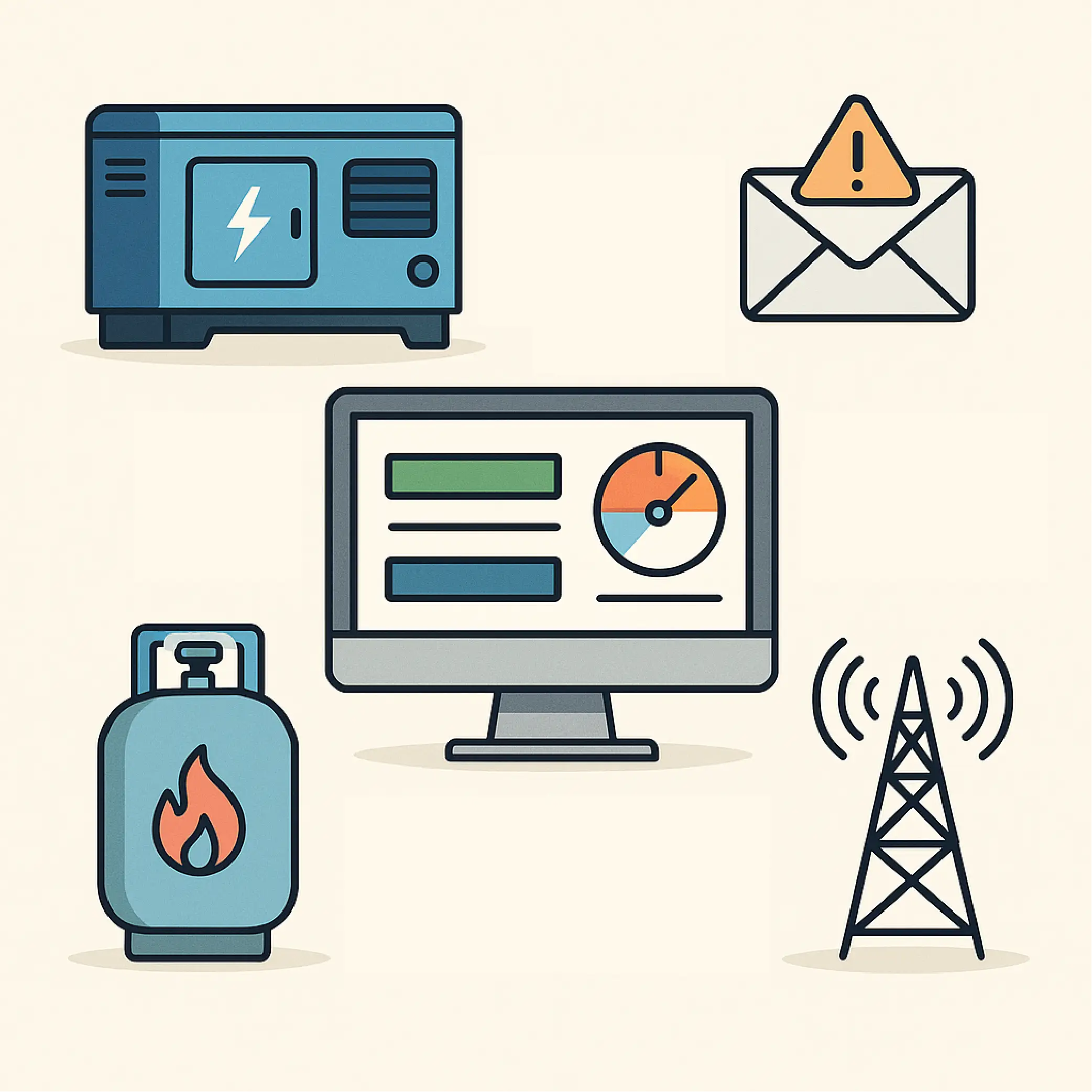Check out our White Paper Series!
A complete library of helpful advice and survival guides for every aspect of system monitoring and control.
1-800-693-0351
Have a specific question? Ask our team of expert engineers and get a specific answer!
Sign up for the next DPS Factory Training!

Whether you're new to our equipment or you've used it for years, DPS factory training is the best way to get more from your monitoring.
Reserve Your Seat TodayWhen you're managing remote telecom or utility sites, you have one job above all else: keep everything running - no matter what.
And when the grid goes down, generators become your most important source of backup power. But generators are only as reliable as the fuel feeding them.
For one DPS client, that fuel came from a mix of propane and diesel tanks spread across multiple remote locations. While the power systems were in place, visibility into fuel levels was not.
It's a common situation, but that doesn't mean it isn't risky.
Let's break down where things went wrong, what could've gone better, and how this client is now actually taking control of their fuel monitoring.

If you're responsible for several critical remote sites, downtime is unacceptable. At sites with either a diesel or propane tank for emergency power, you need good visibility into those fuel levels.
Ask yourself: Can you tell - right now - how much fuel is in each tank? If your answer is "no" or "not exactly," you're already in danger.
That's exactly the problem this client was dealing with. They had:
That kind of setup might work for a little while until it ultimately fails.
If a tank runs dry during a storm or outage, your site goes dark. Equipment shuts down, alarms stop working, and network traffic halts. Plus, you probably won't know anything went wrong until users complain or you lose contact with your monitoring systems.
You're stuck playing catch-up, and paying the price.
In many cases, well-intentioned people try to patch the problem with low-quality fuel sensors or manually checking tanks.
Off-the-shelf sensors are typically designed for basic consumer use. They might give you an LED display of remaining fuel or an analog reading, but they don't integrate into SNMP managers, MODBUS-based monitoring systems, or T/Mon master stations.
If you can't collect alarms, trigger notifications, or consolidate data from multiple sites, you don't have remote visibility.
Sending techs to remote locations just to check tank levels is a massive time and cost burden. Even worse, it only gives you a snapshot in time.
And in places like Alaska, where fuel tanks are flown in, you can't afford to plan resupply flights based on rough estimates.
Many solutions on the market are specific to either propane or diesel, but not both. This client needed to monitor multiple fuel types in a single system. Anything less would create confusion, require training on multiple platforms, and increase integration headaches.
Some employees, especially in large enterprises, get nervous about sensors that require software installs or unsecured cloud platforms. This creates friction with IT teams, and delays deployment.
You need secure, on-prem, and standards-based monitoring that can pass the IT sniff test.
Let's step back and ask: What should fuel monitoring look like at your remote sites?
Based on this client's situation (and hundreds of others we've worked with), the ideal system would include:
And most importantly, your system needs proven hardware that can survive harsh environments, from deserts to tundras.
That's what this client was looking for. And with DPS, that's exactly what they found.
When the client got in touch with Ron Stover from DPS, the conversation quickly turned from unknown possibilities to specific solutions.
The client described a need to monitor both propane and diesel tanks, collaborate across departments (engineers, generator techs, supervisors), and streamline visibility for everyone involved.
Ron was able to walk them through a solution using:
For diesel tanks, depth is the most common way to measure. DPS sensors give you real-time depth readings, which are then translated into usable fuel level data. These sensors are rugged, field-tested, and integrate directly with NetGuardan RTUs using either the 0-5VDC or 4-20mA output standards.
Propane tanks can also be integrated, using slightly different sensors. Ron even sent over a technical paper showing the propane setup, and noted how easily it could be modified to support diesel tanks, too.
With DPS gear, there's no guessing. The data flows directly into your central alarm master, such as T/Mon, or any third-party SNMP manager.
Whether you're using MODBUS, SNMP v1, v2c, or secure SNMPv3, your systems will understand the alarms.
The client wanted multiple people looped in. With DPS systems, that wasn't a problem.
Ron added everyone to the email distribution list and provided a refreshed quote to reflect their current setup.
Security is always a concern, and DPS devices are built with telco-grade IT compatibility in mind. Web interfaces are accessed locally or over secure connections.
That means no sketchy software to install and no cloud vulnerabilities. You just get rock-solid monitoring gear.
The proposed system was more than just theory.
Ron referenced other DPS clients in remote regions like Alaska, where fuel tanks must be airlifted to sites that are inaccessible by road. In those locations, guesswork isn't just inconvenient, it's dangerous. Our clients have actually had fatal remote-site-maintenance flights before.
The solution had to be accurate, rugged, and reliable in all conditions.
The good news is the same sensors, RTUs, and monitoring strategies that work in the Alaskan wilderness are pretty much guaranteed to work for you, no matter your environment.
If your site has fuel tanks, it needs monitoring.
Before ending the call, the client also mentioned a possible future need for monitoring HVAC systems.
This is where DPS's long history of innovation pays off. Since our NetGuardian RTUs and HVAC Controllers are modular and customizable, adding AC monitoring later will be a natural extension, not a rebuild.
It's all part of our bigger goal to provide total site visibility across power, environment, and equipment alarms.
If you've worked with other vendors before, you've probably noticed they bolt on monitoring as an afterthought.
Maybe it's part of a generator package, or a cloud-only "smart" sensor. Maybe it's even a system that doesn't speak your protocols.
At DPS, monitoring is not a bolt-on. It's the main event.
We design and build our own RTUs, we write the firmware, and we test our gear in real-world extremes. We support this gear with a U.S.-based team of experts who actually understand telecom, utility, and industrial environments.
We don't just sell you a product. We help you deploy it, train your team, and customize it if needed.
That's why we've been around since the 1980s, and why clients keep coming back.
With a DPS fuel monitoring setup, you'll get:
If you're managing remote sites, and depending on fuel tanks for backup power, you can't afford to guess.
Give your team the visibility they need to plan fuel deliveries, avoid outages, and extend the life of your generators.
If this sounds like the solution you've been waiting for, the next step is easy:
Call DPS Telecom at (559) 454-1600
Or email us at sales@dpstele.com
We'll walk you through sensor options, tank compatibility, protocol integration, and everything else you need to know. We'll even send you the same detailed fuel-monitoring setup guide we shared with this client.
You don't have to figure this all out alone.
Let's design a fuel-monitoring system that gives you excellent visibility and zero surprises.

Andrew Erickson
Andrew Erickson is an Application Engineer at DPS Telecom, a manufacturer of semi-custom remote alarm monitoring systems based in Fresno, California. Andrew brings more than 18 years of experience building site monitoring solutions, developing intuitive user interfaces and documentation, and opt...